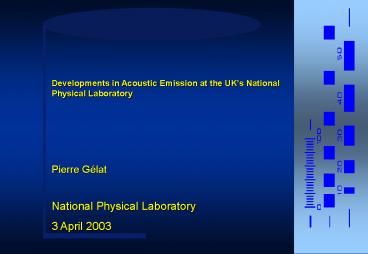Pierre G - PowerPoint PPT Presentation
1 / 15
Title: Pierre G
1
Developments in Acoustic Emission at the UKs
National Physical Laboratory
Pierre Gélat National Physical Laboratory 3
April 2003
2
The Finite Element Method
- The FE method is a numerical method to solve
arbitrary PDEs - The method consists of approximating the
structure in small domain portions called finite
elements - Each element has a set of material properties
associated with it (Youngs modulus, material
density, Poissons ratio, etc.) - A set of output quantities (e.g. displacement)
can be obtained for given forcing/boundary
conditions
http//www.npl.co.uk/npl/acoustics
3
Axisymetric and Three Dimensional Transducer
Modelling
- Use of PAFEC 8.6 Vibroacoustics software (soon to
be upgraded to 8.8) used for modelling the
behaviour of ultrasonic and audio-range
transducer, with fluid loading or in vacuum, for
both continuous and transient excitation - Allows the coupling of vibrating structures to
the modelling of finite and infinite regions of
fluid (boundary elements, wave envelope elements) - Piezoelectric elements can be defined
- PAFECs mathematicians are working with NPL both
to extend the functionality of the software and
to provide NPL with bespoke software to tackle
specific modelling problems - Quantities routinely obtained from PAFEC include
acoustic pressure, structural displacement and
electrical impedance - Sensitivity analysis and optimisation
capabilities
http//www.npl.co.uk/npl/acoustics
4
Sensor Modelling Using the Finite Element Method
- Understanding the dynamics of piezoelectric
sensor - Investigating the effect of variations in design
on overall sensitivity - Designing novel sensor configurations
- Sensitivity analysis and optimisation
(sensitivity vs. bandwidth)
http//www.npl.co.uk/npl/acoustics
5
AE sensor modelling
- Sensor is assumed to be axisymmetric
- Piezoelectric material is PZT5-A
- Apply unit voltage across PZT5-A between 0.1 MHz
and 1MHz - Obtain electrical impedance
http//www.npl.co.uk/npl/acoustics
6
Electrical Impedance of AE sensor
7
Modelling of AE reference facility
- Aim is to develop a methodology to model a simple
AE system from the electrical excitation of the
reference transducer to the electrical output of
the sensor - Requires the combination of more than one
technique - one to model the transducer and sensor
- the other to model the stress wave propagation in
the medium - NPLs Finite Element (FE) method used to
- predict displacement output of transducer for a
given electrical input - predict electrical response of sensor for a given
displacement at its face - Fraunhofers Finite Difference/Integral (EFIT)
method used to - predict displacement as a function of time at a
given point in an elastic medium
http//www.npl.co.uk/npl/acoustics
8
Experimental arrangement
- The reflective coating is Aluminium or Chromium
- The displacement equivalent noise floor of the
interferometer is around 3.5 pmRMS
- Out-of-plane displacement history of surface
measured using interferometer - Repeated with sensor coupled in place of
interferometer
9
Modelling of AE reference facilityComparison of
NPLs FE and Fraunhofers EFIT method
Peter D. Theobald
- Comparison performed using a simple problem for
validation - point displacement excitation
- small cylindrical glass block allows treatment as
an axisymmetric problem - displacements compared at chosen points
.
.
Force f A sin (2pft) . B sin (pft) excited at r
0, z 0
http//www.npl.co.uk/npl/acoustics
10
Reference source - Finite Element modelling of
conical transducer
11
Reference source - Finite Element modelling of
conical transducer
12
Modelling of AE reference facilityComparison
results at 200 kHz
13
Modelling of AE reference facilityComparison
results at 200 kHz
14
Modelling of AE reference facilityComparison
results at 200 kHz
15
Modelling of AE reference facility - Conclusions
- Validation is complete and shows good comparison
between techniques - Work is now progressing on the modelling of a
complete system comprising of source transducer,
glass cylinder and sensor - If successful this should produce a complete
transfer function for the AE system for each wave
mode received at the sensor - Next stage of work is to model the NPL test
facility - would provide more information for the
calibration of sensors - could be combined with a calibrated reference
source to provide system calibration































